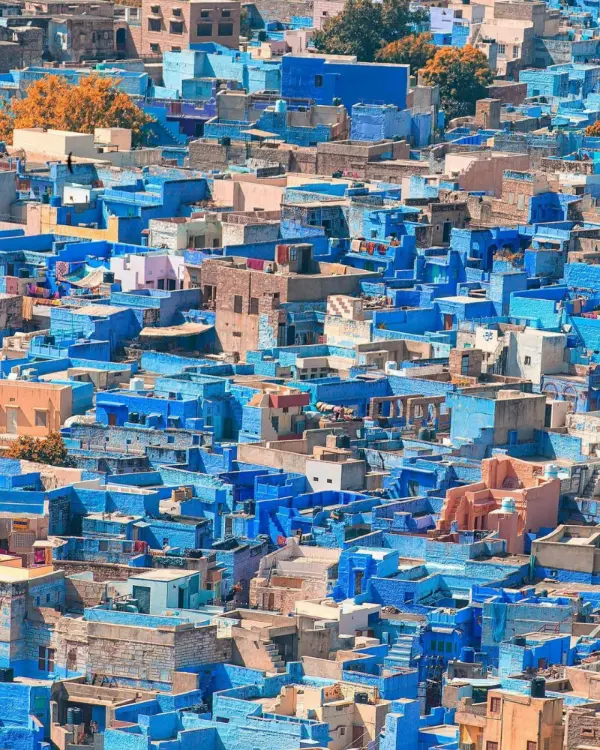Subscribe for more updates!
Stay updated with our latest design insights by entering your email below.

Step off the train or walk through the city gates, and the desert air hits you with a dry, almost tangible force. Jodhpur, Rajasthan’s celebrated Blue City, rises from the heat in shades of indigo, stone, and dust. By evening, the walls of Mehrangarh Fort glow in mauve light, while the houses below glimmer in their blues, layered and uneven but beautiful all the same. This is no still-life painting. It is a living city, its alleys and markets full of movement, stories, and the daily rhythm of desert life.

From above, the blue houses appear almost dreamlike. They climb the hillside beneath the fort, scattered like a sea of color. Centuries ago, Brahmins painted their homes this shade to honor Lord Shiva, and the pigment proved practical too, cooling interiors through long summers. Up close, the color isn’t uniform. Some walls are freshly painted, others are fading, chipped, or marked with murals. Life plays out against them—children racing barefoot, cows nosing through narrow lanes, women balancing brass pots on their heads
Mehrangarh towers over everything. Built in 1459 by Rao Jodha, it is one of India’s most formidable forts, both fortress and palace. The climb to its gates is steep, the iron spikes on the doors a blunt reminder of how seriously defense was once taken. Inside, the contrast is striking: jeweled palanquins, golden thrones, and airy halls named for pearls, flowers, and mirrors. Courtyards fall silent here, and from the ramparts the entire city unfolds, an ocean of blue fading into the desert. For those after a thrill, zip-lines stretch across its walls and gardens, giving a rush of speed and air above the centuries-old stone.

The real character of Jodhpur lies in its streets. In Navchokiya or Chandpole, the blue is at its brightest. Tuk-tuks weave past, vendors shout over each other, and the scent of cardamom and frying snacks lingers in the air. Mornings are best, when light cuts through balconies and the city feels like it’s waking just for you. Rooftop cafés are perfect for a chai and a view of the fort hovering above the rooftops.
Getting lost is part of the charm. Turn a corner and you might find a tiny shrine, a painted staircase, or a group of kids posing with wide grins for your camera.
Toorji ka Jhalra, the old stepwell, is a striking sight, a geometric pit of stone steps leading down to still water. Restored in recent years, it has become both a local hangout and a favorite with photographers. Not far away, Jaswant Thada stands in quiet contrast, its marble glowing white against the desert backdrop. Its latticed screens and calm gardens feel like a retreat after the crush of the bazaars. For a view worth the climb, Pachetia Hill offers a sweeping look across the whole Blue City as the sun drops and temple bells ring out.

Sardar Market, with its clock tower keeping watch, is where the city beats loudest. Stalls spill over with spices, fabrics, and silver. The colors are dizzying, the bargaining half play and half business. Shopkeepers may pull you in with stories or hand you a cup of sweet tea as you browse bandhani scarves or leather shoes. Do not leave without trying a creamy makhaniya lassi or a hot, green-chilli vada straight from the pan.
For travelers seeking comfort, Jodhpur has mastered the balance. Umaid Bhawan Palace offers royal luxury, while smaller havelis provide intimacy within the old lanes. Well-curated tours pair the city’s heritage with modern touches: guided walks through the bluest alleys, cooking lessons in family homes, or camel rides that carry you out into the desert for sunset. The best experiences keep you connected to the city rather than separate from it.

From Jodhpur, the desert opens wide. Bishnoi villages nearby preserve traditions of craftsmanship and conservation. Balsamand and Kaylana lakes are quiet spots for sunset, and right at the fort’s edge, the Rao Jodha Desert Rock Park shows what careful conservation can bring—native plants thriving in what was once bare, rocky ground.
Winter, from October to March, is the ideal season. Days are clear and cool, nights crisp. Stays range from palace hotels to modest guesthouses tucked in blue-painted alleys. If possible, choose one with a rooftop view. Watching the city light up in the morning or soften into evening is something you carry home.

To know Jodhpur is to move with its rhythm: sipping chai, haggling in markets, slipping into its alleys, always with Mehrangarh somewhere in sight. The city lingers, not just for its color but for its pulse. The blue walls, the narrow streets, the fort standing guard—they all speak of a place where history and daily life still meet in the open air.